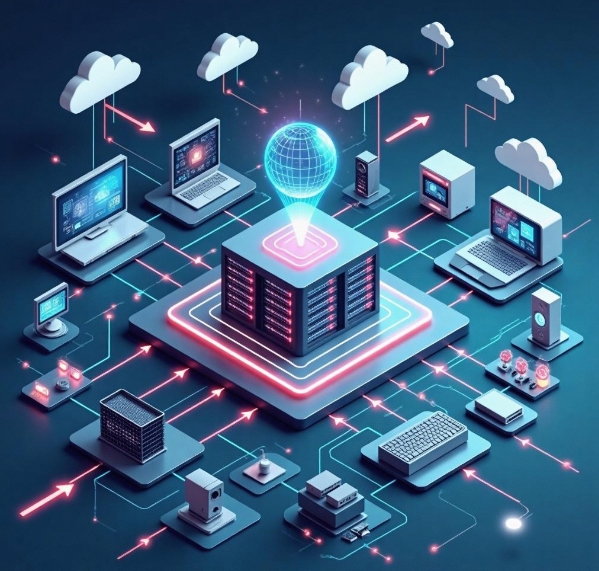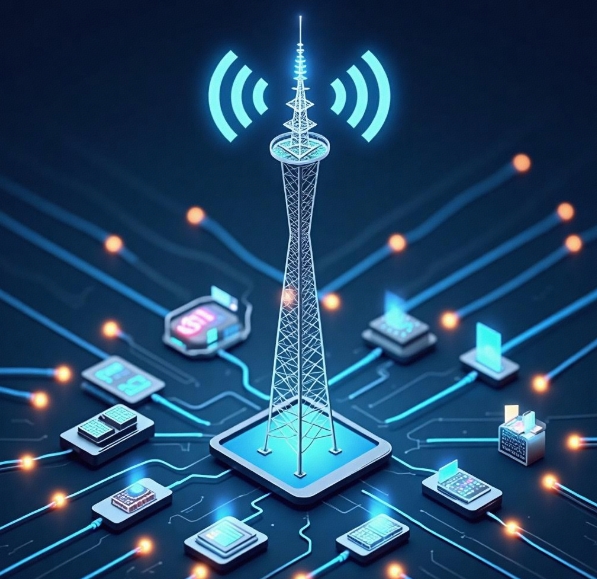Network Optimization and Data Transfer Speed in IoT Development
- latest articles
- 1.DApp Development & Customization: Merging Diverse Market Needs with User Experience 2.Analysis of the Core Technical System in DApp Project Development 3.How to achieve cross-chain interoperability in Web3 projects? 4.How does the tokenization of points reconstruct the e-commerce ecosystem? 5.How to Set and Track Data Metrics for a Points Mall? 6.What is DApp Development? Core Concepts and Technical Analysis 7.Inventory of commonly used Web3 development tools and usage tips 8.Development of a Distribution System Integrated with Social E-commerce 9.Six Key Steps for Businesses to Build a Points Mall System 10.What is DApp Development? A Comprehensive Guide from Concept to Implementation
- Popular Articles
- 1.Future Trends and Technology Predictions for APP Development in 2025 2.Analysis of the DeFi Ecosystem: How Developers Can Participate in Decentralized Finance Innovation 3.From Zero to One: How PI Mall Revolutionizes the Traditional E-commerce Model 4.DAPP Development | Best Practices for Professional Customization and Rapid Launch 5.How to Develop a Successful Douyin Mini Program: Technical Architecture and Best Practices 6.Recommended by the Web3 developer community: the most noteworthy forums and resources 7.From Cloud Computing to Computing Power Leasing: Building a Flexible and Scalable Computing Resource Platform 8.Shared Bike System APP: The Convenient Choice in the Era of Smart Travel 9.How to Create a Successful Dating App: From Needs Analysis to User Experience Design 10.From Design to Development: The Complete Process of Bringing an APP Idea to Life
The Internet of Things (IoT), as an emerging technological revolution, is rapidly transforming our lifestyles and work patterns. By connecting various physical devices through networks to enable real-time information transmission and processing, it builds a vast network ecosystem. With the continuous increase in IoT devices and the diversification of application scenarios, how to improve IoT network performance, especially data transmission speed, has become a significant challenge for developers and researchers.
In the development of IoT, network optimization and the enhancement of data transmission speed directly impact device performance and user experience. This article will delve into the basic concepts of network optimization, bottlenecks in IoT data transmission, influencing factors, and solutions.
I. Network Optimization in IoT
The core feature of IoT is the interconnection and data exchange between devices, and network optimization is the foundation for ensuring this feature is efficiently realized. Network optimization involves multiple aspects, including bandwidth management, latency control, congestion control, and routing optimization.
1.1 Bandwidth Management
IoT devices come in a wide variety, including smart home devices, health monitoring devices, and transportation devices. Different devices have varying data transmission needs, and how to reasonably allocate network bandwidth is a key issue in IoT network optimization. For example, in a smart home system, devices like smart locks and smart bulbs require small amounts of data transmission, while devices like cameras and sensors require larger data volumes. Therefore, the network must allocate bandwidth according to the needs of different devices to avoid excessive bandwidth consumption that could affect overall network performance.
1.2 Latency Control
In IoT applications, the transmission of large amounts of real-time data demands low latency. For instance, in industrial automation control systems, real-time data collected by sensors must be transmitted immediately to the control center for timely responses. If latency is too high, the system may fail to process critical data in time, affecting production efficiency or even causing safety hazards. Therefore, latency control is a crucial aspect of IoT network optimization.
1.3 Congestion Control
As the number of IoT devices increases, network congestion becomes increasingly severe. When there are too many devices or excessive data traffic, network congestion may occur, leading to a significant drop in data transmission speed and even packet loss. The core goal of congestion control is to ensure network stability under high loads. By employing appropriate congestion control algorithms, the throughput and stability of IoT networks can be effectively improved.
1.4 Routing Optimization
Data transmission in IoT often relies on multi-hop routing, where data passes through multiple relay nodes to reach its destination. Due to the widespread distribution of IoT devices, the selection and optimization of routes are crucial. By dynamically choosing the optimal route, the path length of data transmission can be reduced, latency lowered, network congestion alleviated, and transmission efficiency improved.
II. Bottlenecks in IoT Data Transmission
Despite significant progress in IoT technology, improving data transmission speed still faces numerous bottlenecks in practical applications. The following are several main influencing factors:
2.1 Network Bandwidth Limitations
Network bandwidth is one of the most fundamental factors affecting data transmission speed. In IoT environments, since device connections may rely on various wireless communication technologies such as Wi-Fi, Bluetooth, and LoRa, the bandwidth and transmission capabilities of these technologies vary. Particularly in remote or low-power scenarios, network bandwidth is often limited, resulting in data transmission speeds that cannot meet demands.
2.2 Wireless Signal Interference
Most IoT devices rely on wireless communication technologies, and wireless signals are susceptible to various interference factors during transmission. For example, in dense urban environments, a large number of devices may use wireless signals simultaneously, and interference between these devices can cause signal attenuation, thereby reducing data transmission speed. Additionally, physical obstacles like walls and metal objects can also affect the quality of wireless signal transmission.
2.3 Data Redundancy and Compression
In IoT applications, many devices collect large amounts of sensor data, which often have a certain degree of redundancy. How to reduce the transmission of redundant data during transmission and use data compression techniques to improve transmission efficiency is an important way to increase data transmission speed. Data compression not only reduces bandwidth usage but also decreases latency and improves overall network performance.
2.4 Energy Consumption Limitations
Many devices in IoT, such as sensors and smart home devices, often need to operate stably for long periods, so battery life and energy consumption are important considerations. When designing network transmission schemes, it is necessary to balance the relationship between data transmission speed and power consumption. Excessively high data transmission speeds may lead to rapid battery depletion, thereby affecting device availability and stability.
III. Solutions to Improve Data Transmission Speed
To address the network bottlenecks and performance issues in IoT, the following technical solutions can effectively improve data transmission speed.
3.1 Adoption of 5G Technology
5G technology is the latest development in the field of wireless communication, offering higher bandwidth, lower latency, and greater network capacity, providing stronger support for IoT. Especially in large-scale IoT applications, 5G can deliver more stable and high-speed data transmission channels, solving issues of insufficient bandwidth and high latency in existing technologies. For example, in intelligent transportation systems, 5G enables high-speed real-time data transmission, supporting efficient communication between vehicles and road infrastructure.
3.2 Edge Computing
Edge computing is a technology that pushes data processing and computing capabilities to the edge of the network, placing data processing as close as possible to the data source. Through edge computing, IoT devices can obtain and process data more quickly, reducing the latency associated with traditional cloud computing. The application of edge computing can effectively enhance the real-time performance and responsiveness of IoT networks, thereby improving data transmission efficiency.
3.3 Data Compression and Optimization
Data compression technology is a crucial means to improve data transmission speed. By compressing collected sensor data, data volume can be reduced, bandwidth resources saved, and transmission efficiency enhanced. For example, using advanced compression algorithms for video data can significantly reduce data transmission volume while maintaining image quality. Additionally, data deduplication techniques can help eliminate unnecessary redundant data, further increasing transmission speed.
3.4 Protocol Optimization
Common transmission protocols in IoT, such as MQTT and CoAP, are typically designed as lightweight protocols to reduce the burden of data transmission. However, in some cases, the performance of the protocols themselves needs further optimization. For example, by optimizing packet structure and reducing redundant protocol headers, transmission efficiency can be improved while ensuring data integrity. Moreover, selecting appropriate communication protocols can also achieve optimal performance in different application scenarios.
3.5 Network Slicing Technology
Network slicing technology involves dividing a physical network into multiple logical networks, providing independent network resources and quality of service guarantees for each logical network. In IoT, using network slicing allows for customized network configurations based on the needs of different application scenarios. For example, for applications requiring high real-time performance, higher bandwidth and lower latency can be allocated, thereby improving data transmission speed.
IV. Conclusion
With the continuous development of IoT applications, network optimization and the improvement of data transmission speed are becoming increasingly important. Through technical means such as reasonable bandwidth management, latency control, congestion control, and routing optimization, the performance of IoT networks can be effectively enhanced. Additionally, by adopting 5G technology, edge computing, data compression and optimization, and protocol optimization, high-speed and efficient data transmission can be achieved in various application scenarios.
Although network optimization and data transmission speed in IoT still face some challenges, with continuous technological advancements, the communication capabilities of IoT will become increasingly powerful. Future applications such as smart cities, intelligent transportation, and smart healthcare will become more efficient and intelligent.
-

How to Use IoT Development to Enhance Supply Chain Efficiency
With the rapid development of the global economy and the deepening of digital tr···
-

Development and Innovation of the Internet of Things in the Healthcare Sector
With the rapid advancement of information technology, the Internet of Things (Io···
-

Data Storage and Analysis Methods in IoT Development
The Internet of Things (IoT) is one of the most revolutionary innovations in tod···

 Blockchain
Blockchain












